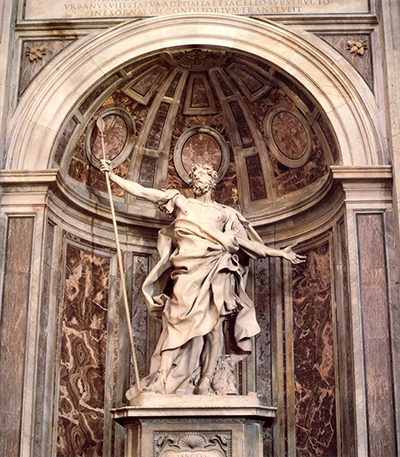Saint Longinus by Gian Lorenzo Bernini is a marble sculpture that was completed in the year 1638. It's located in the north-eastern niche, specifically in the crossing of Papal Basilica of St Peter in the Vatican, and it's over 4m in height.
The Council of Trent, which began in 1545, impacted religious art content throughout the 16th and 17th century. The nineteenth ecumenical council of the Catholic Church (Council of Trent), clarified the elements to be considered in religious artwork. It was then determined that all religious work have to depict Catholic doctrine key aspects, including sacraments and saints. The art produced during that time was supposed to have emotional accessibility, show decorum and be accurate and clear. In creating religious work of art, which includes Saint Longinus, the guidelines had to be followed.
During Crucifixion, the blind Roman soldier known to have speared Christ in the side was called Longinus. After the event, he was purported to have converted and became a Christian, having realised that Jesus was truly the son of God. Longinus was cured and regained his sight when he was converting to Christianity: he experienced a physical and spiritual awakening. Bernini captures the exact moment when Longinus is experiencing his spiritual awakening. Longinus’ face is looking towards the sky with his mouth partially open, indicating his spiritual awakening. Also, the holy lance is pushed aside and his military apparatus and armour lay behind him; this is a symbol of the withdrawal of his job a Roman soldier. With his arms extended, Longinus receives the divine light. In practice, this divine light would come through St. Peter's Basilica's windows.
In the year 1627, Carlo Maderno was replaced by Bernini as St. Peter's Basilica chief architect. He was given full control over new projects in St. Peter's Basilica until 1647, 3 years after the death of the Pope. Bernini oversaw the addition of St. Peter's interior decoration and he was also responsible for the creation of other works, such as Saint Longinus. Saint Longinus by Gian Lorenzo Bernini was one of the 4 statues that were commissioned for the niches that are under the crossing of the basilica, along with statues of St Veronica, St Helen and St Andrew: all of them have relics connected to them in St Peter's. Various artists created small models, which includes Bernini’s St. Andrew. After several discussions with the committee concerning the works, Bernini was hired to create St Longinus and paid a total of 3,300 Roman scudi.
Manipulating the facial expression of a subject to depict personality and inner feelings was a common technique that Bernini, as well as other artists, employed. In 1593, Cesare Ripa, an Italian iconographer, published Iconologia, which is a book that deals with physiognomy idea. Physiognomy was known to be a widespread concept throughout the early 17th century, and Baroque artists heavily employed it. Longinus’ parted mouth and his upward glancing eyes is a good example of physiognomy. Longinus’ facial expression symbolises his inner feelings (his spiritual enlightenment). Also, this technique can be seen in Ecstasy of Saint Theresa by Bernini, where Saint Theresa is looking up to the sky and her mouth is partly open, same as what is seen in Bernini's Saint Longinus.




